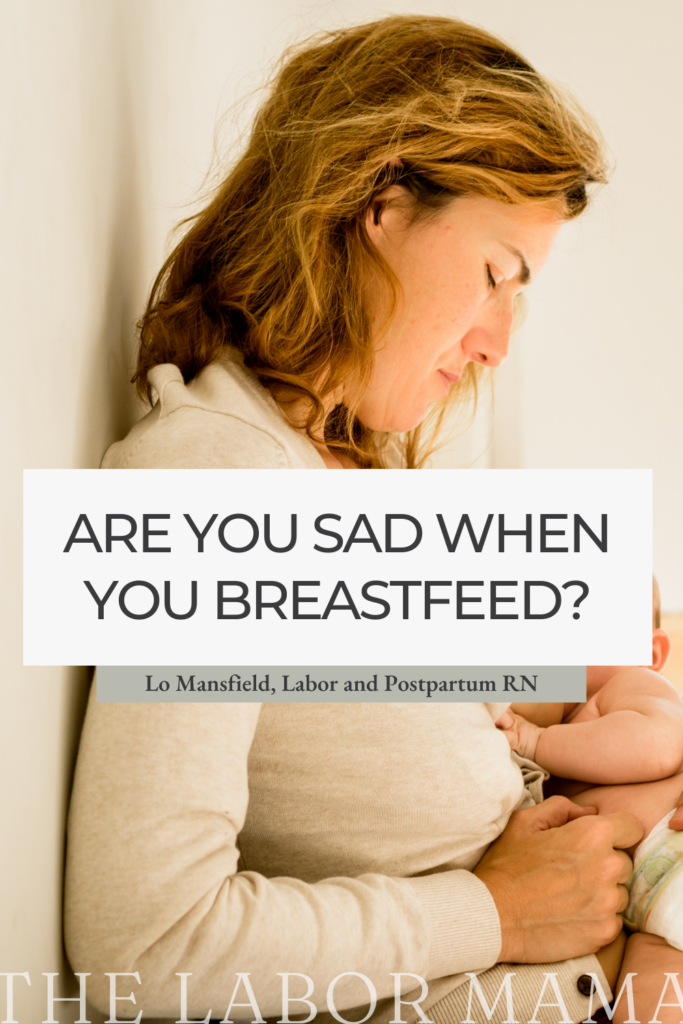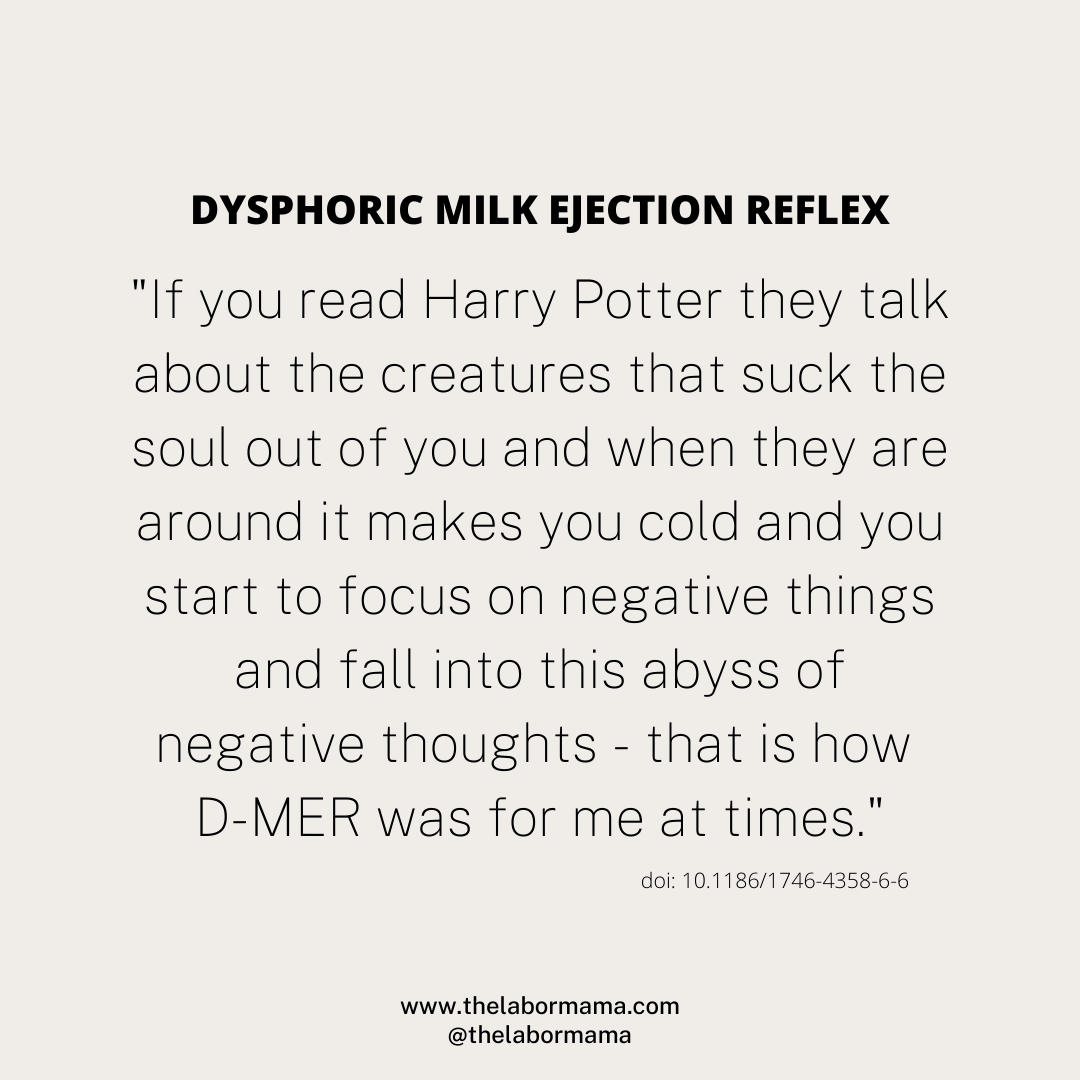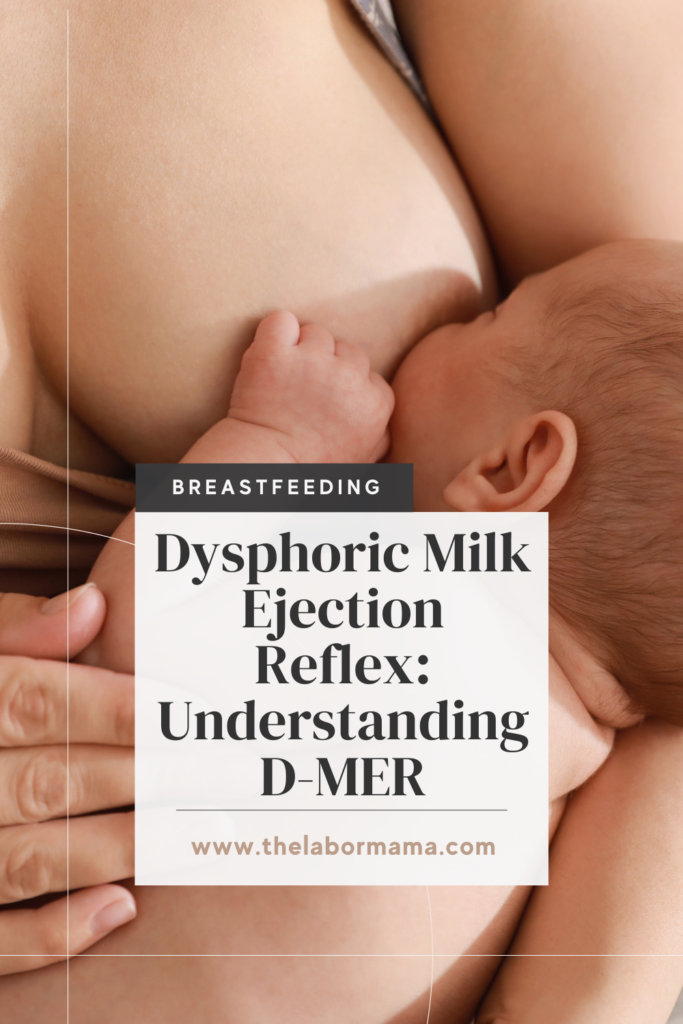Have you ever felt sad when you breastfeed? Anxious? Panicky? Maybe you dread it, because for whatever reason you feel awful when you’re doing it. Guess what? That feeling actually has a name – and understanding what was going on changed everything for me! I hope it can for you too.

Who is The Labor Mama and Why Am I Here?
Hey friend! I’m Lo – also known around here and social media as The Labor Mama. I’ve spent my nursing career in labor, delivery, and postpartum, have birthed 3 of my own babies, have labored thousands of mamas at the bedside, have taught hundreds of students online, and have even delivered a few speedy little babies with my bare hands (oops).
Here at TLM, I offer online birth classes to empower you the way everyone should be. The education + support I offer gives you experience, evidence, and empathy; you’re getting all of my years of “clinical” RN knowledge, beautifully combined with my real experiences as a mama and a nurse. These are not your hospital birth classes (those won’t do it, I promise), and honestly, birth doesn’t follow a textbook or protocol anyway – you need to know so much more than that.
If you want to connect with me further, head to Instagram. There are hundreds of thousands of us over there learning together daily.
What is D-MER?
Dysphoric milk ejection reflex (D-MER) is an inappropriate chemical and hormonal physiological response that happens in a lactating woman just before her milk lets down. D-MER is a physiological response. It is not a psychological response to breastfeeding and it is not a part of the perinatal mood and anxiety (PMAD) spectrum.
D-MER popped onto the maternal wellness scene in 2007. At that time, a lactation consultant Alina Macria Heise, noticed intense negative feelings when breastfeeding (interestingly, she first noted it with her 3rd baby; D-MER does not always show up with the first baby). She began digging and learning more, much of it anecdotal from other women, and soon learned that this was a shared experience for many women that deserved much more space and research.
Dysphoric milk ejection reflex still needs a lot of research. The first study to determine D-MER prevalence was done in 2019. 9.1% of women were found to have experienced D-MER in the sample. These early studies provide good groundwork, but there is much more to learn, including best ways to support those suffering from D-MER.

What does D-MER feel like?
In case studies and anecdotal reports, the feelings of D-MER are described in a wide variety of ways, from wistfulness or homesickness to self-loathing, dread, grief, anxiety and panic. Many women report a “hollowness” or “emptiness” – a “pit in the stomach.” The feelings often come on like a “wave” and dissipate within minutes after let-down.
Some women note D-MER only with their initial let-down, while others feel it with each let-down during a feed. Others report not feeling D-MER at all or feeling it much less when milk expression occurs via a pump. For some, D-MER gets lighter or disappears as the months go by, while others experience it until their child is completely weaned.
Ultimately, it is important to remember that the D-MER experience is variable and exists on a spectrum. D-MER exists in three loose categories: despondency, agitation, or anxiety D-MER. The experience is extremely individual for each women within these categories.
Why does D-MER happen?
Though the research at this point is not entirely clear, it is believed that D-MER is related to the hormones oxytocin, prolactin and dopamine. Oxytocin is related to the milk ejection reflex (MER) and helps move milk out of the breasts. Prolactin is involved in milk production – and this is where dopamine (a feel good hormone) gets involved. Dopamine inhibits prolactin, so dopamine has to fall in order for prolactin to rise and milk to be produced. Normally, the balance between these two hormones is appropriate, but in women who suffer from D-MER, dopamine falls too much and too abruptly and the woman is left with her experience of dysphoria (D).
Currently, the only “risk” for D-MER is a prior history of it. It’s appearance and intensity is unrelated to prior medical history or life circumstances (like trauma, depression, loss, etc.), though many women report feeling similar feelings as they did during another difficult or traumatic season in their lives (more of a deja vu effect). It is also not the same thing as postpartum depression or baby blues, though it can coincide with them and be harder to notice.

What can I do if I am sad when I breastfeed?
There are few evidence-based plans of care for those who suffer from D-MER. Many women with mild symptoms report feeling better simply by knowing what it is – that idea of “name it to claim it.” If the woman is not at risk of weaning because of her D-MER, most care providers recommend education and basic lifestyle changes (rest, decreased caffeine, good hydration, and exercise) as the plan of care. A prescription or dopamine-increasing medication may be used with physician oversight if one has more severe D-MER.
If you believe you may be suffering from D-MER, it’s important to remember that it is a reflexive condition. You cannot talk yourself out of it, this is not something you’ve done, and you don’t hate the feeding relationship you have with your child. You are a good mother – and you are not alone in this space.
*There’s a full discussion about all of this on our Instagram community, including my own experiences. I also share more in this podcast episode with The PUSH Revolution.
Do you think you’ve experienced this? Did you know what was going on? Let me know in the comments! xx- Lo

More resources (and freebies!) for you to take a peek at:
- Comprehensive Birth Plan and Birth Priorities templates
- A complete Third Trimester Checklist
- The RN + mama of 3 Ultimate Packing List
- The Labor Mama online birthing classes for every family
A note: This post may include affiliate links. This means if you make a purchase after clicking a link, I will earn a small commission (thank you)! Rest assured, this comes at no additional cost to you. You can read TLM’s full disclosure here.




I felt this. I was so relieved to find out that it had a name. I couldn’t put my finger on it but I felt an intense sadness/hopelessness and anxiety when I began a pump session or put my second born on the breast. It took so long for me to realise I was feeling that way and it was linked to Milk ejection. It would disappate 30 seconds or so in but it was always lurking around I felt. Ready to come back. Our bodies are producing so much milk, it’s ongoing so it can rise at any time.
I felt I had a bit of postpartum and I felt these feelings after and between feeds at times. And night was the worst.
It only really resolved when I reduced or gave up breast feeding. The feelings of D MER and postpartum lasted for 3-4 months solid. And then would be here or there as I breast fed, particularly if My milk had a higher demand again.
But I am fine now. Keep pushing through ladies. It’s these damn hormones. Honestly I felt so down, like things would never be okay again even though everything was fine. Walks outside made me feel tonnes better..being with my babies and husband. Having loving family members nearby helped.
I promise you WILL get through it and back to those wonderful, safe, secure and abundant feelings in no time at all. Even though it feels like forever, I promise it’s not. Trust in God. Xx
Julie, isn’t it the wildest thing?!? When I figured out what it was I was so grateful to know it had a name, I wasn’t alone, and that it wasn’t something about me or mortherhood that I was doing “wrong” or messing up. I’m so glad you figured it out. It changes so much to just have that knowledge!